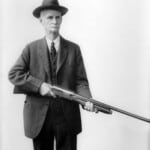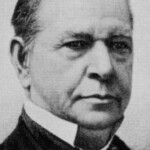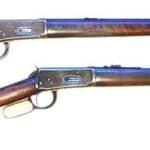
The Winchester Model 1876 rifle stands as a testament to American ingenuity and firearms innovation. Developed by the legendary Winchester Repeating Arms Company, this iconic lever-action rifle played a significant role in shaping the American West during the late 19th century. With its distinctive design and powerful cartridges, the Winchester 1876 became a favorite among frontiersmen, lawmen, Presidents and famous figures of the era.
The Winchester Model 1876 was first introduced in, not so coincidentally, the year 1876. It was designed by the brilliant firearm engineer John Moses Browning, who was already gaining a reputation for his inventive designs. The rifle was initially chambered in a .45-75 Winchester cartridge, a powerful round capable of impressive ballistics. However, Winchester soon expanded the cartridge offerings for the Model 1876 to cater to various shooting needs.
The .45-75 Winchester cartridge, also known as the .45-75 WCF (Winchester Center Fire), was specifically developed for the Model 1876 rifle.
The .45-75 cartridge was a powerful centerfire round designed for long-range shooting and hunting. It featured a bottlenecked case with a rimmed design, which allowed for reliable extraction in lever-action rifles like the Model 1876.
In terms of performance, the .45-75 cartridge had a muzzle velocity of around 1,350 to 1,400 feet per second (410 to 430 meters per second), depending on the specific load and bullet weight. It typically fired a lead bullet weighing around 300 to 350 grains.
The effective range of the .45-75 cartridge was considered to be around 500 to 800 yards (460 to 730 meters), although accuracy and effectiveness would naturally diminish at longer distances. It was primarily used for medium to large game hunting, such as deer, elk, and bear.
Overall, the .45-75 cartridge provided a significant increase in power compared to earlier black powder cartridges, making it well-suited for the Winchester Model 1876 rifle and its intended purposes.
One of the other notable cartridges used in the Winchester 1876 was the .45-60 Winchester. It was designed as a medium-range cartridge, striking a balance between power and trajectory. The .45-60 provided good accuracy at moderate distances, making it suitable for hunting and self-defense purposes. With a muzzle velocity of around 1,300 feet per second (fps) and a bullet weight of 300 grains, it packed a punch while maintaining manageable recoil.
Another cartridge offered for the Winchester 1876 was the .50-95 Express. This cartridge was developed with a different purpose in mind: big game hunting. With a larger bullet diameter of .50 inches and a bullet weight of 300 to 400 grains, the .50-95 Express had exceptional stopping power. It boasted a muzzle velocity of approximately 1,400 fps, making it capable of taking down even the largest North American game, such as buffalo or grizzly bears.
The Winchester 1876 rifle also saw the introduction of the .45-90 Winchester cartridge. This round was specifically designed for long-range shooting and was highly regarded for its accuracy and flat trajectory. The .45-90 Winchester featured a heavy bullet weighing between 300 and 500 grains, which enabled it to retain energy over extended distances. It achieved a muzzle velocity of around 1,300 to 1,400 fps, making it a formidable choice for long-range marksmanship.
The Model 1876 rifle was a large and heavy firearm, weighing around 9 to 10 pounds (4.1 to 4.5 kilograms) depending on the configuration. This made it cumbersome to carry and handle, especially during extended periods of use or when hunting in challenging terrain. Its size also made it less maneuverable in close quarters, such as thick woods or brush.
While the lever-action mechanism of the Winchester 1876 was an improvement over earlier rifles, it still had a slower rate of fire compared to bolt-action rifles or more modern repeating firearms. Operating the lever to chamber a new round required manual effort and could be slower than simply cycling a bolt. This reduced the rifle's overall rate of fire, potentially impacting its performance in scenarios requiring rapid and sustained fire.
The Winchester 1876 rifle was built with a robust and reliable design. It featured a solid frame construction, which made it durable and able to withstand the pressures generated by the powerful cartridges it chambered. The lever-action mechanism, while not as fast as some later designs, was still dependable and resistant to jamming or malfunctioning when properly maintained.
Due to its size and the powerful cartridges it chambered, the Winchester 1876 rifle had a noticeable recoil and muzzle rise when fired. The recoil could be uncomfortable for shooters, especially when firing multiple rounds in quick succession. Additionally, the muzzle rise could affect the shooter's ability to quickly acquire and reacquire targets, particularly during rapid-fire situations.
Famous figures of the Old West and beyond adopted the Winchester Model 1876, cementing its place in history. One of the most notable figures associated with the rifle was none other than Theodore Roosevelt. Before becoming the 26th President of the United States, Roosevelt used a Winchester 1876 during his time as a rancher in the Badlands of North Dakota. Roosevelt cherished his Winchester, considering it a reliable companion on his hunting expeditions.
Another prominent individual known for his use of the Winchester 1876 was the legendary lawman Wyatt Earp. Earp, who gained fame for his involvement in the Gunfight at the O.K. Corral, relied on his Winchester 1876 as his primary long arm. The rifle's reliability and firepower made it a preferred choice for Earp, who often faced dangerous and unpredictable situations in the Wild West.
In conclusion, the Winchester Model 1876 rifle holds a significant place in firearms history. Its versatility and diverse cartridge offerings made it suitable for various shooting applications, from medium-range shooting to long-range marksmanship and big game hunting. The physical attributes and ballistics of the cartridges used in the Winchester 1876 showcased a range of power and performance options. Combined with its association with famous figures like Theodore Roosevelt and Wyatt Earp, the Winchester 1876 became an enduring symbol of American frontier prowess. Even today, it stands as a revered piece of firearms heritage, reminding us of a bygone era where the West was won and legends were made.
If you'd like to join discussion groups on the Winchester 1876 Centennial Rifle, here are some groups:
- CASCity.com's The Winchester 1876 Rifle Forum
- Winchester Arms Collectors Forum - Model 1876
- Winchester Owners Association - Winchester Model 1876
If you know of any forums or sites that should be referenced on this listing, please let us know here.



